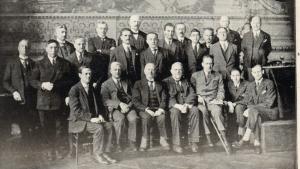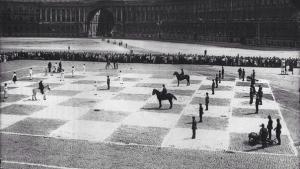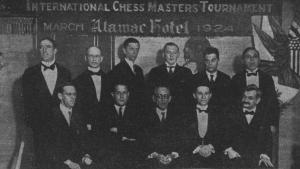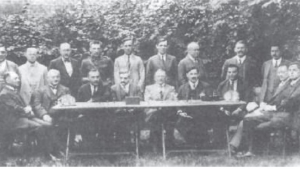
Let’s face it. This decade is a bit of a slog. The war choked off young talent, with the exception of Euwe and (briefly Torre), and the decade was spent with the same ten or twelve players, all of whom had emerged on the international scene ...

I've been spending far longer than I meant to on the Alekhine-Bogoljubow match because ... it was a really good match! It was certainly the fighting-ist championship match since Lasker-Steinitz 1894 and may well have been the fighting-ist match of...

The match quieted down a little after the torrid pace of the first eight games — but only by a little. Now it was five decisive results in eight games, as opposed to six. And, after the wild start, the dynamic for the rest of the match was s...

These Alekhine-Bogoljubow matches have a bad reputation — which is undeserved, at least in the case of the first match. The chess world liked the idea of having Capablanca as the world champion and got obsessed with the prospect of a rematch...

Starting around 1929, Capablanca’s life starts to assume the aspect of a tragedy. More than for just about anybody else, there’s a sense with Capablanca of being born with a very particular fate — to be the world champion —...

Dear Friends,
I have a post up on the chess.com home page about the book of A Century of Chess (Volume 1).
- Sam
Aron Nimzowitsch made his début at Barmen 1905 as a gifted 19-year-old — and finished in third-to-last-...

One of the quirks of learning chess history is that it makes you pull out the atlas and learn these really obscure US towns. Cambridge Springs is a railroad town in western Pennsylvania that for a short time boasted a world-class hotel. Lake ...

Dear all,
Please do consider purchasing the first volume of the Century of Chess series from Amazon. Your purchase helps to keep the series going!
- Sam
The Capablanca tournaments at the end of the 1920s have exactly the asp...

As a reminder, the book of this series, A Century of Chess: Book One: 1900-1909 is available on Amazon in Kindle and paperback. I'm picking up the series in 1928.
Bad Kissingen was meant to be the start of Capablanca’s rehabilit...

Dear Chess Blogging Community,
I am thrilled to share that A Century of Chess: Book One: 1900-1909 is published and available for purchase on Amazon in both paperback and kindle.
This really has been a labor of love and has be...

FIDE — the Féderation Internationale des Échecs — has had a deeply vexed career and, fittingly, the organization got off to a rocky start. Founded in 1924 as an outgrowth of the Paris Olympic Games, the organization strug...

I had no idea that this tournament existed, which — given what a chess history buff I am —says something about how overshadowed it was by the Alekhine-Capablanca match occurring at the same time. It actually was an extremely stron...

We’ve left the match at its midway point — after Game 17 — with Alekhine leading Capablanca by a game. The players had kicked off a streak of draws at Game 13 and it continued with colorless draws in Games 18 and 19. In the somew...

Well. This is what we’ve all been waiting for.
Between you and me, chess in the ‘20s can get a bit tedious. There’s no new talent really — only Euwe — and, even though it’s the peak of classical chess, w...

Kecskemet was one final tune-up for Alekhine before his world championship match, and it was a sight that the chess world was already becoming used to — Alekhine tearing through a tournament with terrifying force. He still had limitations in...

1927 was a very good year — the height of the Roaring Twenties. And it was an especially good year in New York — the year when the Babe Ruth Yankees won 110 games and swept the World Series. It was good times, fast living, and if an in...

One thing about the history of American chess is that you find yourself reaching for the atlas looking up such unlikely locations as Cambridge Springs, PA, Lone Pine, CA — and also Lake Hopatcong.
Lake Hopatcong turns out to be ...

A surprise for me in playing through the tournaments of the 1920s is how long some of the players I think of as stalwarts of the era took to arrive on the scene. Spielmann was a confirmed middle or bottom-of-the-packer until his breakout at S...

Probably no other chess player has been as consistently amusing to his grandmaster cohort as Rudolf Spielmann. Spielmann was, by all accounts, a very simple person — the last person, really, whom one would expect to be a high-achieving menta...

There is a case to be made that this is the single most significant tournament ever held.
The logic for that argument would run that the defining story of 20th century chess was the creation of the Soviet chess machine, and the Soviet...

Marienbad had the misfortune of being held too close to Baden-Baden. Some of the stronger players were evidently too exhausted to take part, and Marienbad had the ragged feel of an after-party.
It is important in chess history, though...

From a sporting perspective, these were the storylines in chess in the mid-1920s: 1.the invincibility of Capablanca, the question of whether anybody would ever come close to him; 2.the surprising resurgence of Lasker, winning a pair of internation...

Chess in the Soviet Union got off to a slow start. In the 1910s, the Russian Empire had clearly been the coming power in chess, but between the war and civil war virtually all of the leading Russian players — Alekhine, Rubinstein, Nimzowitsc...

This is the quintessential tournament of the decade — much as St Petersburg 1914 is for the 1910s and AVRO for the 1930s. It included all the leading players of the era, with the exception of Rubinstein, and was a thrilling, fast-paced race ...

After his match loss to Capablanca in 1921, it would have been safe to assume that Emanuel Lasker would more or less retire. He was 52, he had always had a challenging relationship to chess competition, sometimes, even at his peak, going years wit...

























